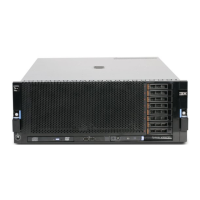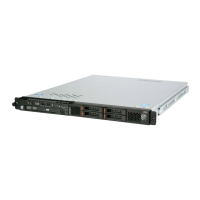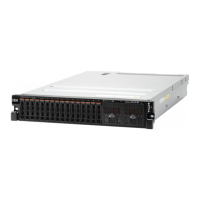Lockstep memory mode
This topic describes the lockstep memory mode and the DIMM population sequence.
Lockstep memory mode supports the memory mirroring and memory rank sparing features. When you use
lockstep memory mode, consider the following:
• Lockstep memory mode provides the best memory RAS features.
• DIMMs must be installed in pairs across the memory channels (two DIMMs in each memory channel),
alternating between the DDR3 or DDR4 channels.
• Each pair of DIMMs in the DDR3 or DDR4 channels must be populated with identical DIMMs. That is, the
DIMMs must be identical in size, organization, etc.. For example, the DIMMs in slots 9 (DDR3 or DDR4
channel 0) and 15 (DDR3 channel 1) must be identical.
• The memory channel operates at the DDR3 or DDR4 channel transfer rate.
• The amount of memory installed in lockstep memory mode is the amount of memory that is available for
use.
For more information about the DIMM population sequence for lockstep memory mode, see “Memory
mirroring in lockstep mode” on page 58 and “Memory rank sparing in lockstep mode” on page 59. For more
information and notes about installing DIMMs, see “Installing a memory module” on page 46..
The following table lists the DIMM installation sequence for lockstep memory mode:
Table 12. DIMM population sequence for lockstep memory mode
DIMM installation order
Lockstep mode with memory
mirroring disabled
Lockstep mode with memory
mirroring enabled
1 DIMM connectors 9 and 15 DIMM connectors 1 and 9, and DIMM
connectors 15 and 19
2 DIMM connectors 6 and 24 DIMM connectors 6 and 10, and
DIMM connectors 16 and 24
3 DIMM connectors 1 and 19 DIMM connectors 2 and 8, and DIMM
connectors 14 and 20
4 DIMM connectors 10 and 16 DIMM connectors 5 and 11, and
DIMM connectors 17 and 23
5
DIMM connectors 8 and 14 DIMM connectors 3 and 7, and DIMM
connectors 13 and 21
6 DIMM connectors 5 and 23 DIMM connectors 4 and 12, and
DIMM connectors 18 and 22
7 DIMM connectors 2 and 20
8 DIMM connectors 11 and 17
9 DIMM connectors 7 and 13
10 DIMM connectors 4 and 22
11 DIMM connectors 3 and 21
12 DIMM connectors 12 and 18
Chapter 2. Installing optional devices 57

